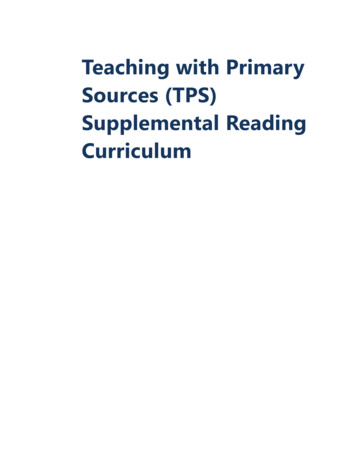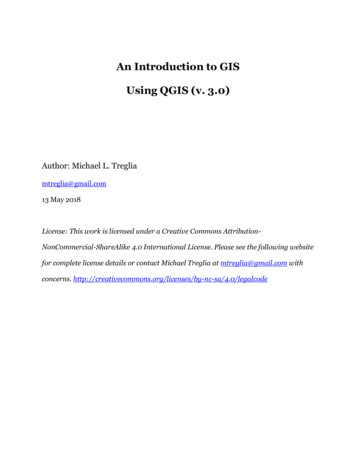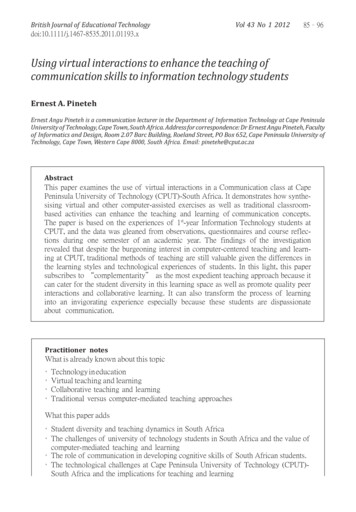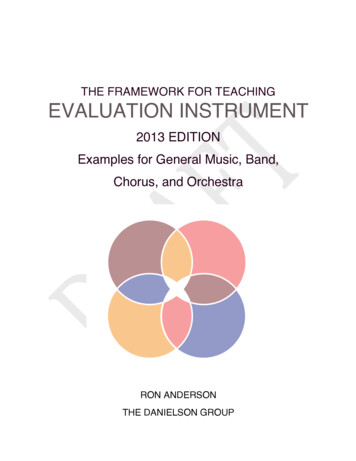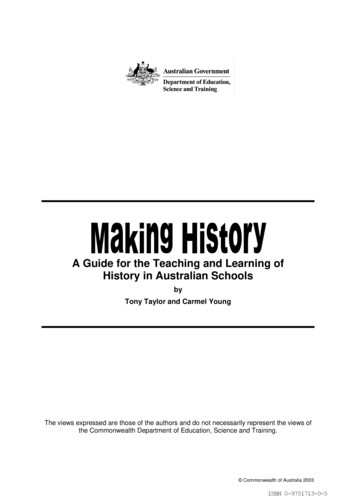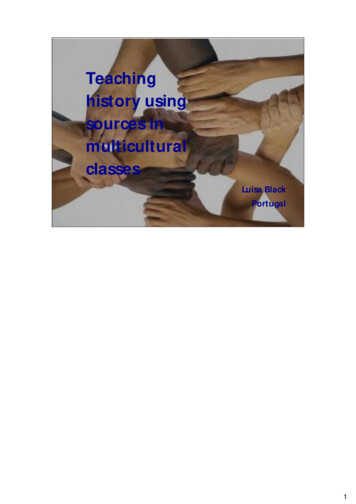
Transcription
Teachinghistory usingsources inmulticulturalclassesLuisa BlackPortugal1
Who are the teachers?
Who are the teachers?
Who are the teachers?Teachers are the product of agiven societyThey are subject to all the sameinfluences, emotions andprejudices that affect theirstudents and their families4
Who are the teachers?Because teachers are unawareof their own beliefs - theyoften remain unchallenged.5
Culture is like an iceberg
Culture is like an othesfoodperceptionsbeliefsvaluesDeepcultureWhat one thinks and how one thinks is determined by one’s cultureThe act of thinking is mediated through one’s own cultureOur cultural databaseCultural Sensitivity: Understanding the needs and emotions of your own culture and theculture of others.7
The sounds of silencePeople communicate without words: thesmile, the look, the rising of the eyebrows,or elbows, etc.Non verbal messages have differentmeanings in differentcultures/communitiesThe paradox of culture is that language – the system most often used totranslate culture is, by its own nature, poor to fulfil this taskNinety percent of what we think about a person is determined in the first ninetyseconds we meet them.8
Issues related to teachers’ perceptions1. A decisive factor in the learning outcomesresults from the teachers’ perception of theirstudents as learners.2. These perceptions are based on subjectivereadings of students’ socio cultural background,academic and behavior characteristics.3. Teachers organize their strategies accordingly.9
Issues related to perceptions and labels1. Teachers water down knowledge inresponse to students social class andethnicity2. The question of different goals ofteachers and expectations of students(content might exacerbate the tension)3. Teachers should be very aware of labels,stereotyping, identity issues, etc.10
What is history teaching?History teaching is a complex task thatinvolves transforming subject matterinto forms that are meaningful tolearners, while retaining the integrity ofthe subject didactic and didactic transposition its full complexity11
History should be taught in its fullcomplexityTeachers should notpresent history as asimple subject: a linearnarrative and a bag offacts.The reasons behind thefacts are more importantthen the chronologicalknowledge of the facts.The octopus12
13
History TeachingTeach the factsKnowledgewhat to knowBy giving answersTeach the skillsInterpretationSourceshow to thinkdifferent perspectivesBy asking questions14
Prizren September 200915
History TeachersShould be able to:Ask questions more open endedly(more creatively)Focus on the learning
Born in Cambodja, came to the US in t980How does Theoung Mim represent her multiple identities in this image? What do you notice about the face she paints? Which part of the portrait do you think represents Mim’s parents’ expectations?Which part represents her? Do any of you ever feel like you have two identities? Why?17
Theoung Mim Being a Cambodian woman meanshaving to maintain two identities. One ismy parents’ expectations and the other iswho I really am. My painting depicts these two sides,which are sometimes hard to blend.18
What is identity?- Identity like history is complex and can beseen from different perspectives- Understanding of self and otherness- Identity (our own or someone else’s) is not alinear process- It is an open-ended process19
Personalise historyShare experiencesEmpathySimilaritiesDifferences20
Professional CommunicationDeveloping communication skills in theclassroom with students from differentcommunities is a process that requires trust,awareness, sensitivity, respect, and honesty.Competence is a constantly evolving processof adaptation and refinement.21
To facilitate communication, teachersneed to:Develop listening skillsVerify perceptionsAsk for feed backResist the temptation to make hastyjudgements5. Cultivate cultural awareness6. Accept challenges1.2.3.4.7. AdaptListening more carefully and more responsivelyExpressing myself more clearly and more completelyQuestion of attitudes and values22
Fernando PessoaThe more differentfrom myself, themore real someoneseems to me,because it dependsless on mysubjectivityLisbon 1888-1935Book of Disquiet23
Who are the students?
Underage festivalsIndividual differences (e.g. gender, physical characteristics, peer relations, familyconditions, values, etc.) affect the way students learnEthnicity may influence perceptions of difference27
28
29
Looking into the future?Reading wordsThe importance ofunderstanding themeaning of wordsReading imagesThe importance ofunderstanding themeaning of imagesBreaking home Rules, by Norman RockwellDifference of the reading words and the reading images generations.The changing role of literatureThe importance of the imagePast or future?Prizren September 200930
Visual SourcesVisual sources are powerful tools, providinginsights into the past.Visual sources are (and should be treated as)sources of information.Visual sources can be read as texts in theirown right, not as mere illustrations.Prizren September 200931
Visual Material– The message conveyed by visualmaterials creates representations of thesociety that might be unbalanced– Teachers need to develop theircompetences to analyze visual materials– Questions of balanced ethnic, race andgender representations– Questions of reading visual materialsEducation for allWhat does it really mean?32
33
What questions do I need to ask?
38
39
40
41
43
Giacomo Gastaldi, Della navigationi e vuaggi, 3º V.,1556.48
Multicultural Context-People approach problems differentlyClear communication is essentialGoals should be clear to allDeveloping joint strategies leads to greatersuccessAvoid blaming and labellingAvoid stereotypesEveryone has different strengths to bring tothe collaborative processWe need reflective teachers for changing attitudes and in consequence schoolsA better understanding of culture in societyAn increase in communication between different culturesA more adapted attitude to the context of cultural diversityA better capacity to participate in social interactionas vozes das culturas minoritárias são ignoradas, excepto quando elas falam de níveis deactividades culturais tais como a música, a dança, a cozinha e hábitos sociais.uma educação que tem em conta a diversidade cultural tem de estar intimamenterelacionada com os princípios que orientam movimentos dos direitos humanos.49
The 21st Century: multiculturalism- The 21st century is going to be one ofunprecedented ethnic and religious mix.- In the past, multicultural societies havetended to only flourish under imperial rule.- Multiculturalism within the context ofdemocratic citizenship: multiculturalism is notthe cause of present discontents but part ofthe solution.51
The French Football Team for theEuropean Cup 2008
The French Football Team for theEuropean Cup 1959
To look at the content through the eyes ofthe students:1. Accommodating students’ personal knowledgeand experience2. Finding out students’ potential as history thinkers3. Understanding what/why students value aboutthe past, and how to include this in the lessonsplanning4. Respecting the culture of the community (ies)54
Matching of curriculum and pedagogy with learners’abilities and interests– Varying tasks– Experimenting with team learning– Involving learners in action planningand independent activities– Encouraging students to reflect on andreview their own progress– Providing assessment tasks that buildconfidenceImproving history learning55
Mia CoutoAt the doorstep ofmodernization, we need toremove our shoes. I haveenumerated seven dirtyshoes that we need to leaveat the doorstep of moderntimes. There are manyothers. But I had to chooseand seven is a magic number.
1. The idea that others are guilty and we are2.3.4.5.6.7.victims.The idea which states that success is not thefruit of labour.The prejudice that the person who criticizesyou is an enemyThe idea that changing words changesthingsThe shame of being poor and the cult ofappearances.The passivity in front of injusticeThe idea that to be modern, we have tocopy others
Fernando Pessoa The more different from myself, the more real someone seems to me, because it depends less on my subjectivity Lisbon 1888-1935 Book of Disquiet 23. Who are the students? Underage festivals Individual differences (e.g. gender, physical characteristics, peer relations, family



